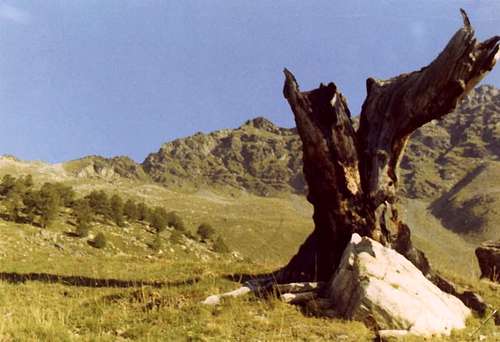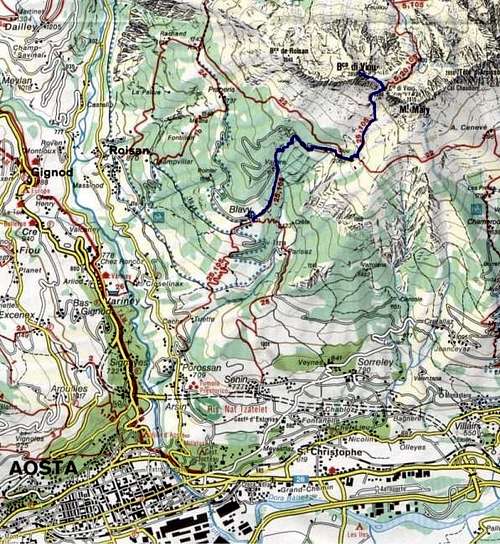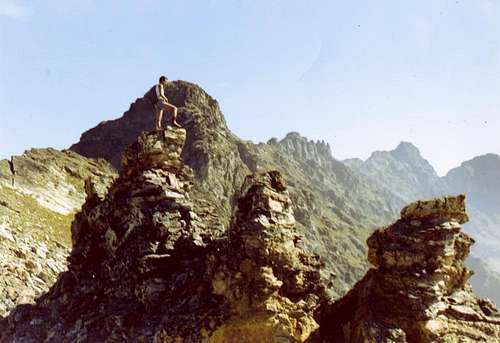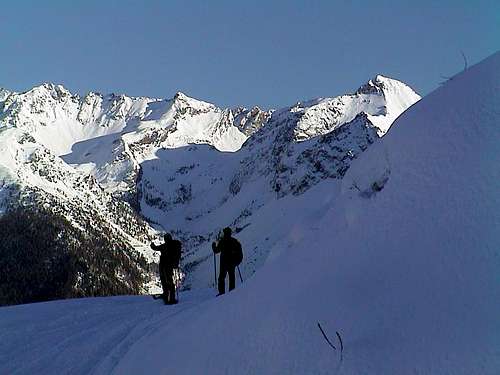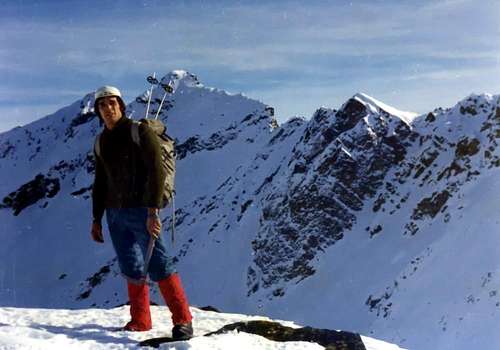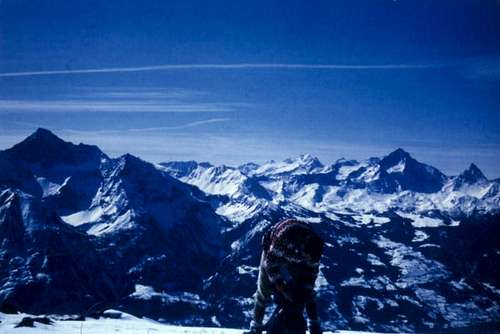-
 824 Hits
824 Hits
-
 80.49% Score
80.49% Score
-
 12 Votes
12 Votes
|
|
Mountain/Rock |
|---|---|
|
|
45.79320°N / 7.37456°E |
|
|
Aosta Valley, Quart-Valpelline Municipalities |
|
|
Hiking, Mountaineering |
|
|
Spring, Summer, Fall, Winter |
|
|
9035 ft / 2754 m |
|
|
Note
|
La montagna chiama i suoi figli, ed essi rispondono fedelmente al suo appello… Osvaldo Cardellina, Diario alpinistico, 1964-65 Page texts: @ OsvaldoCardellina "Osva", passed away on May 2, 2022. Page owners: Christian Cardellina e Osvaldo Cardellina. Any updates from September 12, 2022: Antonio Giani, page administrator, friend and climbing companion. Testi della pagina: @ OsvaldoCardellina "Osva", scomparso il 2 maggio 2022. Proprietari pagina: Christian Cardellina e Osvaldo Cardellina. Eventuali aggiornamenti dal 12 settembre 2022: Antonio Giani, amministratore della pagina, amico e compagno di salite. |
Overview
La Punta oppure Pointe di/de Chamerod (2.752/54 metri circa), assume il nome dalla sottostante località, con un villaggetto formato da alcune costruzioni ristrutturate abbastanza recententemente, era fino agli inizi degli anni Settanta costituito da vecchi rascards, ovvero costruzioni in legno e pietra, sospese tramite alcuni piccoli pilastri su di un basamento in pietra, come da informazioni da parte di un pastore della zona nell' estate del 1971. Costituisce una piccola Sommità, quasi "timida" perché seminascosta alle spalle del più che robusto Mont Mary (2.815 metri), che "invade" sia la Conca di Blavy (ad Occidente) che il Bacino di Senevé oppure Cénevé (a Sudest). Cima non quotata ne denominata su di alcuna carta, manuale o libri di montagna e no. Trattasi del naturale prolungamento della Cresta Nordest del Mont Mary, esattamente nel punto in cui questa piega, formando quasi un perno, decisamente verso Oriente. Invece sul Versante Nordovest precipita con una breve (circa 140/50 metri), giallognola e quasi verticale parete sul sottostante Lago di Arpisson nel Vallone dell'Arpisson in Valpelline. Salita, forse per la prima volta, da Osvaldo Cardellina e Marco Périer il 30 Marzo 1969 in traversata dalla Becca di Viou e ritorno alla medesima ed inoltre percorsa pure in pieno inverno il 23 Febbraio 1975 da parte di Osvaldo Cardellina, Marco Cossard e Giuseppe Lamazzi in un'ascensione senza sci nonché racchette da neve, con partenza dal Villaggio di Blavy (1.475 m) e traversamento in cresta al Mont Mary ed alla Punta di Chamerod, ritorno identico e prolungamento fino alla Becca di Viou (2.856 metri), vetta principale o più nota di questo piccolo comprensorio montano sopra i Comuni di Roisan, Aosta, Saint Christophe e Quart. A seguire ritroviamo l'Intaglio Sudoccidentale di Chamerod (2.740/2 metri circa), assumente il nome dalla viciniora omonima punta risultando quale piccola breccia tra la stessa nonché la Punta Occidentale de Les Prèles (2.750/52 metri circa). Anche quest'ultima nonché adiacente Cima risulta di facile accesso da Mezzogiorno, mentre presenta un versante decisamente ostico a Settenterione, in pratica gemello e parallelo a quello dell'attigua Punta di Chamerod con il quale va a congiungersi in basso ma meno alto di due terzi ed in minor evidenza se osservato da Nordovest, per la quale cosa il transito é sconsigliabile e sicuramente non facile, poiché sviluppantesi in una paretina di 150 metri circa incuneata tra le due costoline rocciose provenienti dall'omonima punta e da quella delle Prèles; é formata da rocce rotte ed abbastanza ripide ed esposte alla possibile caduta di sassi. Tutte queste piccole Sommità possono essere visitate, partendo dal Villaggio di Chamerod oppure dalla Frazione di Trois Villes con inizio al Villaggio di Avisod, in un'unica giornata nella quale inoltre é possibile "legare" le stesse alla salita del Mont Mary oppure della Testa di Arpisson. Partendo invece dalla Valpelline, lungo il Vallone di Arpisson, si può raggiungere in assoluta tranquillità e sicurezza il Colle di Viou e poi traversare al Mont Mary tramite la Cresta Nordovest di facile percorso (I°/I°+) ed alle medesime di Chamerod prima e Les Prèles subito successivamente. Oppure affrontare la salita più impegnativa di uno dei due Colletti di Chaudière, dei quali risulta più abbordabile quello Nordest, anche se per entrambi il percorso rimane esposto alla caduta di pietre.
A) - Il Colletto Sudovest é duplice e risulta posizionato in mezzo ad una serie di dentini rocciosi collocati nella parte inferiore della breve Cresta Nordest del Mont Mary. Nel primo caso bisogna:
a)- risalire la ripida morena al di sopra del Lago di Arpisson (2.487 metri) raggiungendo la base della Parete Nordovest della Punta di Chamerod all'altitudine di 2.580 metri circa; iniziando con una S prolungata al di sotto della medesima si risale per un canale nevoso o roccioso detritico che zigzagando, dopo un diagonale finale a sinistra/destra, esce sulla sinistra dello ultimo dei cinque denti, donde in breve alla Vetta.
b) - Prima del doppio diagonale terminale, uscire invece direttamente per una rampa, in genere "sporca" di terriccio e neve, verso destra che termina alla forcella tra secondo e primo dentino.
c) - Si può inoltre evitare questo stretto canalone e, con percorso un pò meno pericoloso, salire restando sulla destra (Ovest) della costola rocciosa che costituisce la sua sponda orografica di sinistra; in quest caso si ha ancora una duplice soluzione:
1) - dalla morena basale salire con un pendio più aperto appoggiandosi ad una costolina rocciosa per tre quarti della ascensione per poi attraversare a sinistra ricongiungendosi alla via precedente.
2) - Infine si può scegliere di salire in verticale sulla destra uscendo alla successiva e più largheggiante forcella che precede i quattro dentini.
B) - Per quanto concerne il Colletto Nordest o Col Chaudière ufficialmentte inteso (2.680 metri) la scelta risulta univoca ed uniforme dovendo salire in modo lineare, sempre partendo dal Lago di Arpisson, ma tenendosi maggiormente contro il Crestone N-NO che, dalla Testa di Arpisson, scende in direzione del Colle di Foillou (2.073 metri). La salita dei versanti Meridionali (Sudest per il Colle SO e Sud per il Colle NE) invece risulta più semplice e quasi banale:
C) - a riguardo del primo colle si tratta di una semplice, ed a volte in assenza di innevamento, tanto faticosa quanto noiosa ascensione lungo pendii erbosi inframmezzati da massi sparsi.
D) - Quella al Col Chaudière Nordest risulta un poco più impegnativa e, viceversa rispetto al primo, diventa più impegnativa se con neve: ci é capitato il 5 Novembre 1998 di arrivare a 30 metri dal colle e dover rinunciare a causa della neve troppo alta e tale da arrivare quasi alle spalle, che, cedendo all'improvviso, faceva pericolosamente sprofondare tra i grandi "clapeys" o blocchi accatastati con il rischio di fratturare le gambe. Questi percorsi fungono da avvicinamento alle varie salite, per la qual cosa eviteremo di ripeterli nelle routes rimandando alla "Overview" in questione. Inoltre bisogna prendere in considerazione il fatto che l'avvicinamento migliore e più propizio risulta quello da Bivacco Penne Nere al Colle di Viou (2.730, 2.696 meters), con seguente facile scavalcamento del Mont Mary da Ovest ad Est.
First ascents

- First on the Summit: Unknown.
- First in winter: Osvaldo Cardellina and Marco Périer, March 30th, 1969; from Blavy Hamlet and with double traverse from and to Becca di Viou. Also in the middle of winter on February 23th, 1975 by Osvaldo Cardellina, Marco Cossard and Giuseppe Lamazzi in an ascent without skis or even snowshoes, starting from Village of Parléaz or Parleyaz bypassing Mont Mary with round trip to Becca di Viou.
- N-NW Face: Osvaldo Cardellina and Saverio Cusumano, September 03th, 1971; from Chamerod Village and, always bypassing Mont Mary, successive traverse to Becca di Viou.
- NW Face: Osvaldo Cardellina, solo, September 29th, 1972; from Blavy Village and after traverse Becca di Viou - Mont Mary with the mountaineer Aronne Ruffini.
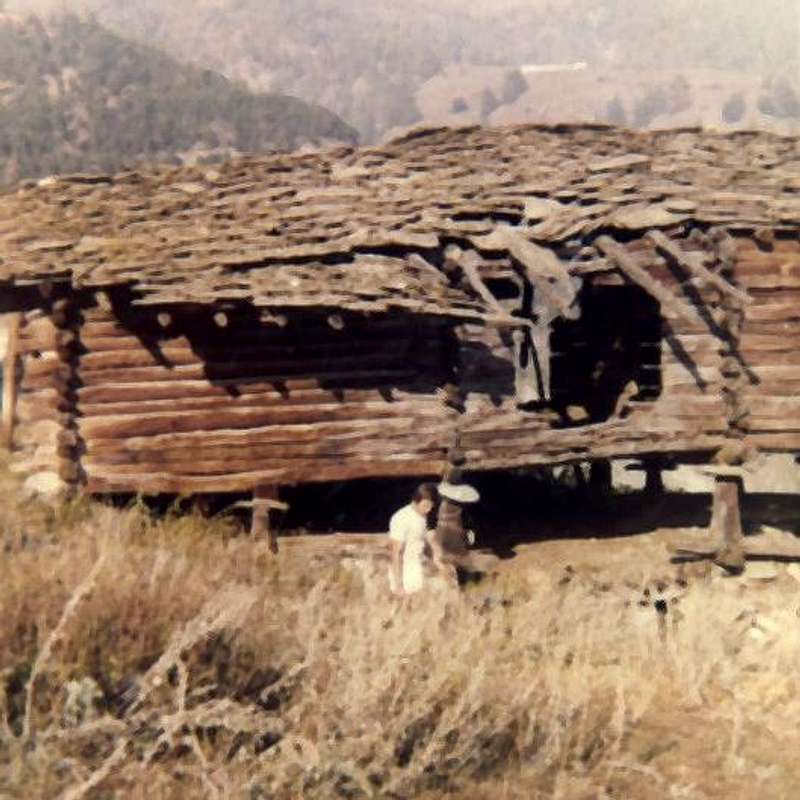
Getting There
BY CAR:
- From TORINO, MILANO, etc: Motorway A5. Exit at IVREA or Quincinetto (PIEDMONT).
- From IVREA Town: in West (Southern side) towards Pont Saint Martin, Donnas, Bard, Champdepraz, Pontey, Fénis, Nus to Quart-Villefranche and Saint Christophe Municipalities (Eastern Side).
- From Courmayeur Resort: in East towards Pré Saint Didier, Morgex, Arvier, La Salle, Saint Pierre, Sarre, Aosta to Saint Chistophe and Quart Municipalities (Western Side).

Specific Road From Aosta Est toll of the highway towards Aosta City and, just after the local small airport, turn to the right toward Saint Christophe Municipality (615m). Follow (take care) signs for Sorreley Hamlet (790m) . A little before it turn to the left and, after passing the Village of Veynes (841m) and the next or almost concomitant Villages of Cretallaz (1.087m), Jeanceyaz (1.092m) and Morgonaz (1.174m), and Prayon oppure Praillon (1.280m) follow up to Chamerod old Village (1.634/38m) located at the foot of Combe de Senevé also Cénevé, but with the route surely closed in winter.
Dall'uscita del Casello dell' Autostrada di Aosta Est proseguire verso la Città di Aosta e, subito dopo aver superato l'Aeroporto Corrado Gex, svoltare a destra verso il Comune di Saint Christophe (615 m) . Seguire attentamente i cartelli per la Frazione di Sorreley (790 m) ; poco prima di arrivarci svoltare sulla sinistra e proseguire verso il Villaggio di Veynes (841 m) , (lasciato a sinistra il bivio per Blavy, cartello Montagne). Continuare a salire oltrepassando i quasi concomitanti Villaggi di Cretallaz (1.087 m), Jeanceyaz (1.092 m) e Morgonaz (1.174 m) e il successivo di Prayon oppure Praillon (1.280 m), dove al tornante seguente inizia la strada poderale con cartello di divieto; salire ancora sino a raggiungere il vecchio Villaggio di Chamerod (1.634/38 m) posto ai pedi della Combe de Senevé, trovando sicuramente la strada chiusa nella stagione invernale.
Route
Reached and crossed Chamerod ancient Villagealong an ancient comfortable muletrack that, rounding to NE, leads to Alpe Les Prèles also better known by the local inhabitants as Les Preyes (1.795m). Going on in the same direction, using a steep path, you get a further mountain pasture in the middle of a wood. Passing West of the fork to Alpe Chavod (2.020m), follow till the pastures beyond the Alpe di Senevé (2.199m) and get it. Form this pasture go Northwest on pastures and scree towards the Colle di Chamerod or, even and maybe better, Southwestern Chaudière Pass (about 2.740/42 meters), between Mont Mary (2.815m) and the two unnamed Summits called Punte de Les Prèles, before Colle Chaudière (2.680m). After passing the boring Southeastern slopes of Mont Mary and keeping more to the right (North-northeast), you go around some rocky banks and through a rocky grassy gully you reach the fairly narrow notch of Colle Chaudière Southwest just beyond a series of four teeth (see photo above top); from this point you continue towards the North as well as integrally and easily along the edge of the ridge, which at the end has some short climbs or at least where you can also use your hands (I°), and then finish on debris up to the Summit. This excursion is however somewhat more appreciable if carried out with hardened and well transformed snow. As for the starting point, the one from Chamerod is better, because it is more direct than the one starting from Avisod Village (1.398m) in Trois Villes; but it must be remembered that while the latter can be reached by car, the itinerary through Chamerod (1.614/15m) actually starts from the hairpin bend immediately after the Praillon or Prayon Pastures (1.280m) , where the dirt farm road starts but with a sign prohibiting unauthorized vehicles.
Raggiunto l'antico Villaggetto di Chamerod, oggigiorno ristrutturato, attraversarlo seguendo un'antica mulattiera che comodamente, con giro a Nordest, porta all'Alpe Les Prèles anche meglio conosciuta dagli abitanti delle varie località ai piedi della Comba di Senevé, oppure Cénevé, siccome Les Preyes (1.795 m); continuando nella stessa direzione, per un sentiero abbastanza ripido si raggiunge un'ulteriore alpeggio diroccato nel mezzo del bosco, oltre il quale, lasciando ad est la diramazione per l'Alpe Chavod (2.020 m), porta ai pascoli sottostanti l'Alpe di Senevé (2.199 m) che in breve si raggiunge. Dall'alpeggio puntare a Nordovest su pascoli alternati a pietraie in direzione del Colle di Chamerod oppure, anche e forse meglio, Col Chaudière Sudovest (2.740/42 metri circa), tra il Mont Mary (2.815 m) e le due elevazioni precedenti il Colle Chaudière Nordest (2.680 m), dette Punte de Les Prèles. Superati i noiosi pendi Sudorientali del Mont Mary e tenendosi maggiormente sulla destra (Nord-nordest) si aggirano alcune banconate rocciose e per un canalino erboso roccioso si perviene all'abbastanza stretto intaglio del Colle Chaudière Sudovest appena oltre una serie di quattro dentini (vedi foto sopra in alto); da questo punto si prosegue verso Settentrione nonché integralmente e facilmente sul filo della cresta, che al termine presenta qualche breve tratto arrampicabile o perlomeno dove si possono usare anche le mani (I°), per poi terminare su detriti fino alla Vetta. Questa gita é comunque alquanto più apprezzabile se effettuata con neve indurita e ben trasformata. In quanto al punto di partenza é migliore quello da Chamerod, perché più diretto di quello con inizio dal Villaggio di Avisod (1.398 m) a Trois Villes (1.390 m); ma bisogna ricordare che mentre questo ultimo é raggiungibile in auto, l'itinerario attraverso Chamerod (1.614/5 m) in realtà prende inizio dal tornante subito dopo l'Alpeggio di Praillon o Prayon (1.280 m), dove parte la strada poderale, ma con cartello di divieto ai mezzi non autorizzati.
ALTERNATIVE ROUTE: But the route, if not more logical, certainly more comfortable is to start from the "Penne Nere" Bivouac (2.730m) just above the Colle di Viou (2.696m). In fact, having reached the same, positioned near a small Summit called Mont Trembloz (about 2.720 meters), through the path n° 5 in the initial part up to Alpe Foillou (2.073m) and then with the intervalleys path n° 105 which climbs from Valpelline in Grand Combin locality (942m) or, on the opposite side, from the path n° 1A/25 or the intervalleys path always n° 105 with departures from the small Village of Blavy (1.471/74 meters, in Saint Christophe Municipality) or by the Municipality of Roisan in Crétaz location (907m) through a farms dirt road, you can make the excursion in a day or with bivouac in the same shelter, breaking the excursion into two days. In the following climb to Mont Mary with the easy NW Crest (be careful, however, if it is covered with ice or with snowy frames generally on the right or South), and then again easily descend with the NE Crest to Col Chaudière SW, whence as in the previous itinerary to the Summit (3h'00 to Bivouac, 0h'30 for the crossing on Mont Mary; altogether 3h'45'/4h'00).
VIA ALTERNATIVE: Ma la via, se non più logica, sicuramente maggiormente comoda consiste nel partire da Bivacco "Penne Nere" (2.730 m) appena al di sopra< del Colle di Viou (2.696 m). Infatti, raggiunto il medesimo, posizionato vicino ad una piccola Sommità denominata come Mont Trembloz (2.720 metri circa), tramite il sentiero n° 5 nella parte iniziale fino all'Alpe Foillou (2.073 m) ed in seguito con il sentiero intervallivo n° 105 che sale da Valpelline in località Grand Combin (942 m) oppure, sul versante opposto, dal sentiero n° 1A/25 o sentiero intervallivo sempre n° 105 con partenze dal Villaggetto di Blavy (1.471/74 metri, Comune di Saint Christophe) o dal Comune di Roisan in località Crétaz (907 m) con strada sterrata interpoderale, si può compiere l'escursione in giornata oppure bivaccare nel medesimo spezzando la gita in due giorni. Nel seguente salire al Mont Mary con la facile Cresta NO (attenzione però se ricoperta da ghiaccio o con cornici nevose in genere a destra o Sud), per poi ancora facilmente scendere con la Cresta NE al Col Chaudière SO, donde come nel precedente itinerario alla Sommità (3h'00 al Bivacco, 0h'30 per la traversata del Mont Mary; in totale 3h'45/4h'00).

When to Climb
In all seasons or Spring, Summer, Fall and Winter.
In tutte le stagioni, ovvero Primavera, Estate, Autunno ed Inverno.
Equipment & Difficulties
Standard mountaineering equipment.
Normale da montagna.
The Normal Route: is assessable as easy hiking for all hikers with an experience pratice of middle-mountain (F/F+).
La Via Normale é da valutarsi adatta ad ogni tipo di escursionista con un pò di pratica di media-montagna (F/F+).
Campings
Remember that free camping is forbidden (except for emergency reasons, over 2.500m, from darkness until dawn).Mountain Condition
- Meteo: you can find all the needed informations at the official site of the Valle d'Aosta Region:
- Valle d'Aosta Meteo
Books and Maps
- "Guida dei Monti d'Italia - Alpi Pennine (Vol. 2)" di Gino Buscaini - Club Alpino Italiano/Turing Club Italiano, Luglio 1970 (In Italian).
- "Ascensioni 1964-1969" Diario Alpinistico di Ilario Antonio Garzotto (unpublished).
- "Diari Alpinistici" di Osvaldo Cardellina e Indice Generale accompagnato da Schedario Relazioni Ascensioni 1964-2019 (unpublished).
- Kompass "Breuil/Cervinia-Zermatt" Carta turistica 1:50.000.
- I.G.C. Istituto Geografico Centrale "La Valpelline" (carta n° 115) Map1:30.000.
- I.G.M. Istituto Geografico Militare - Map1:25.000.
- L'Escursionista Ed. Rimini "Gran San Bernardo-Ollomont" (carta n° 5) 1: 25.000.
Important Information
- REGIONE AUTONOMA VALLE D'AOSTA the official site.
- FONDAZIONE MONTAGNA SICURA Villa Cameron, località Villard de la Palud n° 1 Courmayeur (AO) Tel: 39 0165 897602 - Fax: 39 0165 897647.
- SOCIETA' DELLE GUIDE DELLA VALPELLINE Etroubles-Strada Nazionale, n° 13 - Tel +39 0165 78559 - Valpelline-Loc Capoluogo, n° 1 - Tel +39 0165 713502 (AO) Italia.
- A.I.NE.VA. (Associazione Interregionale Neve e Valanghe).
Useful numbers
- Protezione Civile Valdostana località Aeroporto n° 7/A Saint Christophe (Ao) Tel. 0165-238222.
- Bollettino Valanghe Tel. 0165-776300.
- Bollettino Meteo Tel. 0165-44113.
- Unità Operativa di Soccorso Sanitario Tel. 118.




